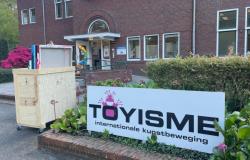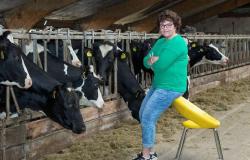In their shared rental house near Wageningen, things slowly started to bother Marieke Meesters and Johan de Jong. Being dependent on a landlord when it comes to making your home more sustainable, the color of your window frames, the number of co-occupants: it became increasingly difficult. ‘We wanted to live more autonomously than you can as a tenant,’ Meesters summarizes their starting point. ‘We didn’t want to achieve that by just both buying a house.’
The ambitions had to be bigger, the two thought. Would it be possible to join the growing movement for alternative forms of housing? Where housing evades ownership and profiteering? Where people do not lock themselves behind their own walls, but live in shared responsibility for each other and for the world?
About the author
Marc van den Eerenbeemt is economics editor for de Volkskrant and writes about, among other things, the housing market and real estate.
Meesters (32, PhD in philosopher) and De Jong (32, PhD in forest ecology) took a look around their own circle. Among their friends from Wageningen University and the climate movement, there appeared to be more who longed for new perspectives on shared housing. Two couples hooked up. First Joeri Willet (33, PhD in environmental technologist) and Rolinde de Haan (29, project manager at climate foundation Trees for All), then Nico Claassens (35, associate professor of microbiology) and Emmy Van Daele (32, PhD student in microbiology).
Leafy
Their eye fell on Huize Veluwezoom on the Utrechtseweg in Renkum. Successful entrepreneurs usually settle on that leafy alley, not the founders of an idealistic residential group. The villa with home office and alarm system was for sale for 750 thousand euros. For the friendly older couple who lived there, caring for a house of almost 1,000 cubic meters had become a bit too much. This also applied to the maintenance of the entire plot of almost 1,400 square meters. ‘Luckily they found us sympathetic,’ says Meesters. ‘The house had been for sale for some time. That gave us time to try to set up our own legal and financial structure.’
The Wegel residential group had it recorded at the notary that they wanted to live together in a non-traditional way. Living with care for each other, ‘like a kind of self-chosen family’, but also with shared concerns about global warming and the decline of biodiversity.
THE HOUSING CRISIS
The shortage of housing in the Netherlands is growing and growing. Home seekers have been registered for years, and owner-occupied houses are affordable for fewer and fewer people. De Volkskrant investigates the causes and consequences of the housing crisis and visits people who are trying to find a solution. Read previous episodes here.
The notary also wrote down their solution. By forming one household as a group of adults, they use less living space. In this way they not only contribute to a solution to the housing shortage, it is also their answer to the increasing individualism in society. As a group, it is also easier to finance the much-needed sustainability of the country house. The villa from 1972 is far from energy efficient.
The villa could be purchased with a small discount, for 735 thousand euros. However, there was an obstacle. If they buy the villa as a foundation or residential association, 8 percent transfer tax must be paid. But they are starters on the housing market, who are normally exempt from this significant tax expense. How could they avoid paying about 60,000 euros?
Self-reliant
The rise in house prices is one of the reasons for the growing interest in living differently, write the authors of Together, a knowledge project on collective living by scientists from TU Delft. Another reason is the growth in the number of singles and seniors. In addition, the need to be a member of a community can play a role in the choice of a shared housing project. This could, for example, be a joint construction project, such as a cooperative of ecologically inspired households or a foundation for a group of self-reliant seniors. According to Together, the initiatives are characterized by self-sufficiency. If these housing options do not yet exist, ‘we will arrange it ourselves’. The report seems tailor-made for the Wegel residential group in Renkum.
The residential group that was being established was able to purchase Huize Veluwezoom. 1.1 million euros was allocated for the purchase plus renovation and sustainability. Of this, 735 thousand euros was for the purchase of the house. The remainder, 365 thousand euros, was for the thorough renovation of the house.
The money came from several sources, such as a sustainability loan, a family mortgage and a ‘jubelton’ (the now abolished tax-free donation for an owner-occupied home). However, the largest part came from a mortgage loan from one of the major banks.
De Haan: ‘We would have preferred a more idealistic bank like Triodos or ASN. But with our construction we could only go to a not exactly green bank. At Triodos the application literally got stuck in the computer system.’ De Jong finds that a bit bitter. ‘We would prefer to stay away from the financial system. But to make this project possible, we had to find a way within that system.’
Construction
Establishing a residential association or foundation was the preferred legal form for purchasing the house. “Then we could have really taken the house out of the housing market, so that it would no longer be subject to speculation,” says De Jong. ‘Then we would all have become tenants. But we really had to get rid of the transfer tax. Otherwise this project would not have been successful.’
A ruse was devised together with the notary. “Legally speaking, we are not a residential association, but a number of people bound by a co-purchase agreement,” says Willet. ‘The fact that such a construction was necessary shows how poorly the Tax Authorities deal with alternative housing options.’
The construction had another advantage, according to Meesters. ‘This joint financial obligation allowed us to qualify as a sustainable household. This way we were able to comply with the zoning plan. This stipulates that the house may only be occupied by one household. Such a provision applies in many municipalities, for fear of pawnbrokers and overcrowding. That is understandable, but also another example of fairly rigid policy that stands in the way of alternative forms of housing.’
The fact that they were forced to make such a legal buck was unpleasant, Meesters emphasizes. ‘But ultimately we just wanted to realize a residential project. It is a constant balance between idealism, time, money and energy.’
Rent
Now the Wegel living group is in the kitchen of her villa, where vegan cooking is done every day for the entire club. The kitchen table is cozy and cheerful with seven people. Everyone has their own room (a double for a couple). The two bathrooms are shared, as are the large sitting room and the barn with workshop.
The first major step in making the house more sustainable has almost been taken, to the relief of many. The exterior walls were insulated for around 200,000 euros, single glazing was replaced by insulating glass and additional rooms were created under the heavily preserved roof. After all that building and carrying, it is time for less practical matters, according to the group. Such as more ‘social dynamics’ and attention to the design.
A tenant has also been brought in (and another one is coming), with a permanent contract, for 500 euros per month. That was an ethical issue for a while; they find collecting rents in itself a objectionable concept. They would have preferred to welcome Sven Etienne (27, mathematician and sailor on the brown fleet) as co-owner. But a purchasing arrangement proved difficult, says De Haan. ‘Then you were stuck with a new mortgage, a higher interest rate and again notary costs.’
So rent was chosen after all. Their tenant is a full member of the residential association, including voting rights. The rental income will also never be used for the owners’ mortgage, but will largely be spent on further sustainability.
Sweat
The aforementioned knowledge project Together sets the condition for successful collective living that everyone makes a free will and conscious choice to participate. All members must be involved in the implementation of the housing project, in order to acquire ‘a share in sweat’. However, the ‘most complex feature’ is joint decision-making, the warning goes. How do you prevent the organization and management from ending up in a mutual battle?
To ensure that the meetings in Renkum run smoothly, the residents have carefully written down their principles. They have also already followed training courses on ‘integrative decision-making’ and ‘deep democracy’. During consultations you want to get all perspectives on the table, Meesters explains. ‘We speak to each other here in a constructive and empathetic manner.’ De Jong: ‘You don’t fight for your own right here, you do it for the group.’
In principle, this association is not intended for children, it has been agreed. Anyone who wants to raise children will first have to discuss this with the group. De Jong: ‘The impact of the arrival of a child on the whole is often underestimated. You see in other groups that a child changes the entire dynamic of the community.’
The residential group is also not eager to have animals on the property. Tibbe, Marieke Meesters’ dog, was lucky to live in the spacious house and garden near the woods of Wageningen. Meesters did give thorough instructions to the entire living group about the correct, dog-worthy handling of the animal.
It is a strange feeling to all live in such an expensive residential area, with the aim of improving the world, Meesters notes. ‘At the same time, it is special to be able to show the neighbors how you can live in such large houses differently. These are generally somewhat conservative people, but their reactions are positive.’
Claassens hopes that their example will be widely followed. ‘This model must be accessible to everyone, regardless of education or income. If the government and banks were to develop a few standard models for both licensing and financing of collective housing, it would make life a lot easier. And more beautiful.’
Tags: Renkum model living group luxurious villa sustainable harmonious
-





